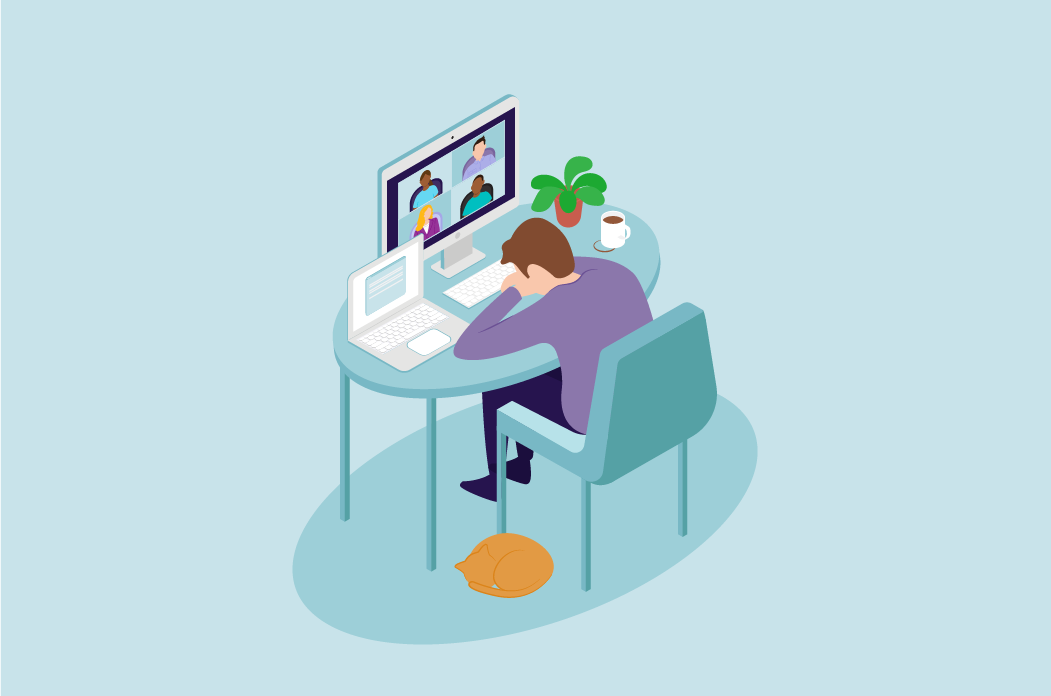
Health Bound Health Network
Due to COVID-19, you may be spending a lot of time on video conferencing platforms, such as Zoom. You may be using video conferencing platforms for work, school, to attend appointments, or to socialize with family and friends. This blog provides a brief overview of what ‘Zoom fatigue’ is, why it happens, and what you can do to reduce its effects.
What is ‘Zoom fatigue’?
- ‘Zoom fatigue’ refers to feeling more tired, burnt out, or drained after online meetings than after in-person ones.
- It is more likely to occur when you have back-to-back online meetings or when you are jumping from one online meeting to the next.
- Although it is called ‘Zoom fatigue’, it can stem from using any video conferencing platform, including Microsoft Teams, Webex, and Skype.
Why are online meetings more tiring than face-to-face ones?
- Looking at a screen for an extended period of time can cause eye strain.
- Conversations require more focus and are less natural. You need to work harder to process non-verbal cues such as facial expressions, body language, and tone and pitch of voice.
- Being able to view your video at all times may make you feel like you are always “on alert”. You may feel like you need to monitor your appearance more than usual in order to show that you are interested in the discussion.
- There can be interruptions that make meetings longer than they would be in-person. For example, people may unintentionally talk over each other, a family member or pet could unexpectedly enter the room, or someone could accidentally unmute themselves and create background noise.
- You may have technical difficulties, such as an unstable internet connection, freezing video, audio that cuts in and out, or difficulties navigating the platform.
How can I reduce ‘Zoom fatigue’?
- Set up a good environment to attend meetings, with upright seating and good lighting. Lighting in the room should be at least as bright as your computer screen to reduce eye strain.
- Avoid scheduling back-to-back meetings. Schedule brief screen-free breaks in between meetings where you can do something else, like read a book, go for a walk, or meditate.
- Limit the number of Zoom meetings you have in a day. Consider whether it’s possible to connect via a phone call, an audio only call, email, or instant messenger instead.
- Avoid multitasking while in a meeting. Before the meeting, minimize irrelevant tabs and log-out of your email and social media accounts to limit distractions.
- If you find that you are too focused on your appearance and ensuring that you appear professional, hide the self-view feature so that you no longer see your video on the screen.
- Follow a routine that includes a consistent sleep-wake schedule and time dedicated for self-care, relaxation, and doing things that make you happy.
References
Callahan, M. (2020). ‘Zoom fatigue’ is real. Here’s why you’re feeling it, and what you can do about it. Retrieved 19 August 2020, from https://news.northeastern.edu/2020/05/11/zoom-fatigue-is-real-heres-why-youre-feeling-it-and-what-you-can-do-about-it/
Daigle, T. (2020). ‘Zoom fatigue’ is setting in: What it is and how to prevent it. Retrieved 19 August 2020, from https://www.cbc.ca/news/technology/zoom-fatigue-is-setting-in-1.5585933
Fosslien, L. & Duffy, M. (2020). How to Combat Zoom Fatigue. Retrieved August 19, 2020, from https://hbr.org/2020/04/how-to-combat-zoom-fatigue
Meisenzahl, M. (2020). What it feels like to experience Zoom burnout and how to avoid it. Retrieved 19 August 2020, from https://www.businessinsider.com/zoom-burnout-video-call-fatigue-from-work-and-school-2020-5
Sander, L., & Bauman, O. (2020). Zoom Fatigue is real – here’s why video calls are draining. Retrieved August 19, 2020 from https://ideas.ted.com/zoom-fatigue-is-real-heres-why-video-calls-are-so-draining/

